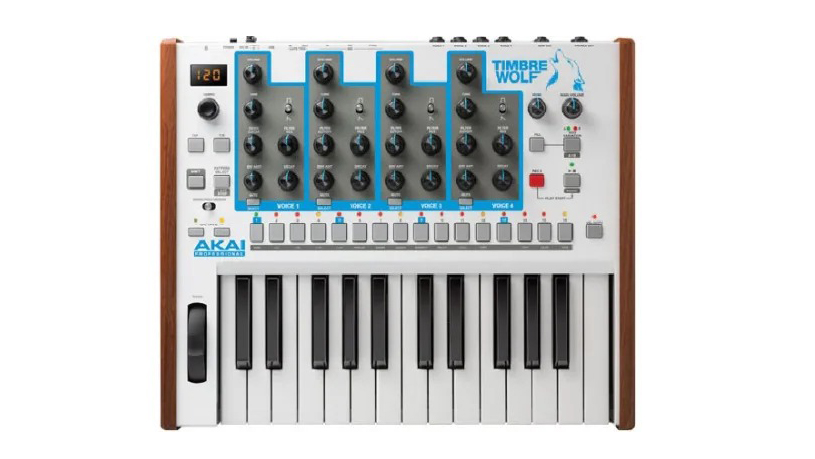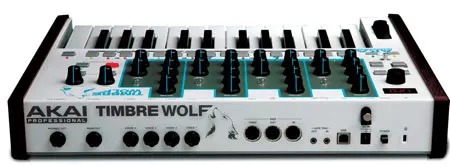Akai Timbre Wolf review
Unusual analogue polysynth with integrated sequencing and a unique sound

Akai’s been making bold moves in the analogue market lately. Last year saw the introduction of the Rhythm Wolf, a peculiar drum machine that polarised the synth community in several ways.
On the one hand, naysayers felt the drums weren’t punchy enough and that the bass synth was out of tune (it was, to be honest). On the other hand, there were users like myself, who found the unit’s exotic sound, solid construction, and affordability a distinction in a growing pack of competitors.
This year, Akai is back with two new contenders in the analog arena: The Timbre Wolf 4-voice analog synth and the Tom Cat, an alternate take on the drum machine that covers different ground from the Rhythm Wolf. Although the Tom Cat wasn’t shipping at the time of this writing, I was among the first to check out the Timbre Wolf.
- The best MIDI keyboards for beginner and pro musicians
- Best synthesizers: keyboards, module and semi-modular synths
- Best pianos: acoustic and digital pianos for beginners and pros
Design and construction
For starters, the Timber Wolf’s construction feels extremely robust with metal panels, great feeling knobs and retro wooden end-caps. The rear panel sports jacks for main out, individual voice outputs, headphones, MIDI In/Out/Thru, USB MIDI and gate I/O for clocking the sequencer (see Figure 1).

Feature-wise, the synth has a unique architecture, as each voice is completely independent, in a similar manner to the Korg Mono/Poly, which allowed you to independently control its oscillators for four-voice operation. Akai’s approach is slightly different, as every voice is its own mini-synth and the unit includes an integrated four-track sequencer that can control any or all of the individual voices. Taken as a whole, this makes the unit quite useful for a variety of applications, both as a groovebox and as an unusual-sounding instrument.
Synthesis engine
Each of the Timbre Wolf’s four voices consists of the same mini-synth found in the Rhythm Wolf, with one notable exception. These voices are actually in tune, and Akai has included a voice-calibration function that retunes the voices should their drift become noticeable over time. In my tests, I was both impressed and relieved that Akai has addressed this issue and can confirm that any tuning deviation is well within a tolerable range for an analogue synth. And it’s worth mentioning here that many of your favourite vintage monosynths include some form of tuning instability. Don’t believe me? Grab the tuner in Logic or Ableton and play a C in every octave and ponder the results. Bottom line—Akai’s new oscillators are now on par with the rest of the analogue market.
As for the architecture of each voice, the Timbre Wolf’s parameter array is strongly reminiscent of the Roland TB-303. That is, there’s a single saw/square oscillator that feeds a lowpass resonant filter, followed by a simple decay ramp envelope that can be applied to both the amp and cutoff. Ultimately, it’s like having a collection of four 303’s that can serve as four monosynths, a polysynth with rotating voice allocation for Mono/Poly and Oberheim tricks, or stacked and detuned for a massive lead sound.
Get the MusicRadar Newsletter
Want all the hottest music and gear news, reviews, deals, features and more, direct to your inbox? Sign up here.
That said, there are still a couple of caveats to Akai’s implementation. For example, each oscillator’s tuning knob only covers the detuning range—basically a semitone in either direction. A wider range would have allowed for interval tunings in unison mode for those oh-so-trendy stacked parallel seventh chords. What’s more, it would have been great if each oscillator included an octave switch, which would have added some range to the Timbre Wolf’s massive lead sounds.
As for the filter, increasing the resonance beyond 60 to 70 percent really thins out the sound in a way that’s cool if you’re looking for pseudo-highpass effects, but misses the target for sounding like a true 303. Adding a touch of gain boost in the filter circuit could have addressed this, but we’ll just chalk it up to the synth’s identity in this case.
None of these issues feels like a deal-breaker in the larger context of the Timbre Wolf. After all, many early analog synths had flat-out weird designs (Korg Sigma and Delta, anyone?), but that didn’t keep their sound from being extremely useful, and more importantly, identifiable. No one will ever mistake a Moog for an ARP, and that’s the key here. The quirks of the Timbre Wolf, like the quirks of the Rhythm Wolf, are part of its sound, and with all four voices layered and detuned, that sound can be incredibly fat at times. And if you want to go really big, you can twist the Howl knob, which not only adds a megaton of distortion but amplifies the overall volume to a dangerous degree. Don’t say I didn’t warn you.
As for polyphonic operation, it’s just a matter of switching the mode to poly and playing chords. The fact that each voice can have its own sound gives chord comping a really unique texture. Or, you can quickly set up each voice identically for a more traditional approach. Unfortunately, there’s no ability to save these patches as presets, which is a bit of a shame in this context.
Sequencing
The Timbre Wolf’s four-track sequencer is surprisingly intuitive and capable. In fact, I was up and running with it in just a few minutes of unboxing the unit. The basics are obvious: Hit Record and Play and start riffing. As you hit keys, the appropriate LEDs light up on the 808-style sixteen-step strip above the keyboard.
At first, I thought the sequencer was going to be a strictly monophonic affair, but glancing up at the synth section, I realized that each voice could have its own discrete sequence. Tapping on a Select button switches the sequence to that voice, so you can repeat the process up to four times, creating fairly intricate patterns rather quickly. Alternately, you can switch the Timbre Wolf to unison mode and have all four voices stacked on the sequence for the first voice.
There’s not much else in the way of editing, except for the ability to add ties, change the pattern length and adjust swing. Each of the 16 sequences includes editable A and B versions, which can be chained together for a 32-step sequence. There’s also a Fill button that interacts with the A/B selector for a bit of added flair. All in all, this approach puts the Timbre Wolf squarely in groove-box territory. While some may complain about the 16-sequence limitation, I can quickly think of at least four other modern products that have equally small banks of sequences, so it is what it is.
MIDI
The Timbre Wolf’s MIDI implementation will happily transmit its sequences as well, which can be useful if you have a larger rig with a few other elements. It’s also multi-timbral, so you can send it up to four discrete sequences for each of its voices. Naturally, the sequencer can also serve as master or slave sync via MIDI, USB, or the pair of gate jacks on the back panel.
On the downside, there’s no way to control the Timbre Wolf polyphonically over a single channel. Rather, its MIDI configuration allows you to access the individual voices sequentially via cascading channel assignments. For example, if you set the master channel to 12, that will play voice one, with the next three voices corresponding to channels 13-15. I was a wee bit disappointed about this discovery, as I really wanted to control the Timbre Wolf from Ableton Live as a secondary polysynth in my rig. Le sigh.
Verdict
With its clever design and distinctive sound, the Timbre Wolf is a credible all-analogue synth with a lot of features that you won’t find anywhere else. With all four voices stacked, its capable of some truly massive leads, and in poly mode, it’s got a one-of-a-kind character that isn’t easily duplicated.
Its four-track sequencer is great for intricate poly-timbral grooves and the whole package is built like a tank. While I can’t recommend it as a first synth for those looking to add analogue to their rig, it’s a very cool box for artists with a larger collection of gear who are after something on the exotic side. If that describes you, then the Timbre Wolf is definitely worth further inspection.
Pros: Four-voice polyphonic. Four-track step-sequencer. Voice rotation allows for unusual sequencing and arpeggio tricks with different sounds on each voice. Roadworthy construction.
Cons: Does not receive polyphonic MIDI information on a single channel. Filter resonance diminishes amplitude below the cutoff. Tuning knob range is strictly for detuning, not intervals.
Bottom line: Unusual analog polysynth with integrated sequencing and a unique sound.
$499
akaipro.com









